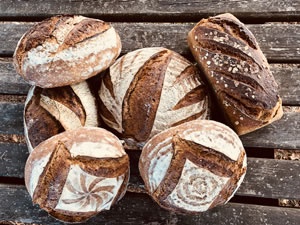Making bread with levain rather than yeast creates a completely different result, and is the only way to make bread really digestible and optimise the flavour of the grains. There’s a lot of complicated talk about levains (starters), but for the type of levain we use, it’s just flour and water that you mix together in equal weights.
Here’s how to make two 1kg loaves (so that you can have two goes at shaping and scoring):
1. Mix together 200g water and 200g half-and-half mix of T80 stoneground flour (strong or high-gluten bread flour) and wholemeal flour. Leave it at room temperature for a couple of days. Then throw half away and replace what you have discarded with the same weight of flour-and-water mix.
2. Do this discarding and feeding every day for 10 days or so, to get the levain established. When you want to use it to make bread, throw half away and feed the remainder with flour and water as normal about 4–6 hours before you want to mix your dough. (If you don’t need it for a few days, put it in the fridge.)
3. Take 770g 25°C (tepid) water and add 11.5g levain. (This is not a misprint and is a MUCH lower amount of levain than in most recipes you’ll see, but it makes for a long, slow fermentation and super-digestible bread.)
4. Then add 1,010g T80 ancient wheat flour – something like John Letts’ Lammas Fayre flour or any fresh, stoneground local alternative (the fresher, the better).
5. Add in 55g rye flour, 36g small spelt and 36g wholemeal (again, stoneground heritage flour if possible, or the best you can find if not). If you can’t find the rye, spelt or wholemeal, add the equivalent weight of your main T80 wheat flour, but the flavour and texture will be much richer and tastier with the full range of flours.
6. Mix by hand, just until the flour and water are combined.
7. Add 27g salt and 57g more water.
8. Mix again by hand until the salt has been absorbed. Don’t mix any more than necessary – the idea is to touch the dough as little as possible and let the levain do the work.
9. Cover and put the dough somewhere coolish – as close to 18°C as you can find.
10. After about an hour, fold the dough. There are plenty of videos online demonstrating dough folding. The idea is to stretch the dough to strengthen it whilst at the same time making sure any hot or cold areas are evened out.
11. An hour or so later, fold again. You can do this 3–5 times at one- to two-hour intervals, depending on how you are fixed for time. If you do more, you’ll probably get a little more strength and evenness of fermentation. If you do less, it’ll be nice bread anyway.
12. Then leave the dough to itself. After 15–18 hours, depending on whether your fermenting spot was slightly warmer or cooler and how full a flavour you want in your bread, give it one last gentle fold and tip it onto a work surface. Keep your hands floured or wet if things feel sticky, and cut the dough into two 1kg chunks.
13. Shape the bread how you like. I’d recommend doing one boule (circular loaf) in a floured basket (or a bowl lined with a floured tea-towel) and one in a bread tin. The bread tin loaf gives a guaranteed result even if the shaping goes wrong.
14. Again, there are plenty of videos on how to shape a boule and how to shape for a tin. Make sure you find a video where the dough is touched as lightly as possible. There are some shaping techniques based on knocking the gas out of the dough. We don’t want to do that. All the fermented gases contain the flavour we want to preserve, so be as gentle as you can with the dough.
15. When the bread is shaped, put it in the fridge. It will ferment a little more before cooling to a point where it stops. After 3–4 hours, it’s ready for baking. You can leave it longer if you like –even overnight. Having the dough cold will make it much easier to get out of the basket and score.
Heat your oven to full temperature – hopefully at least 250°C. For the loaf in a basket, use a casserole dish. Put the dish in the oven to preheat. When it’s at temperature, take out the dish carefully, as it will be extremely hot! Tip out your basket loaf into the dish, score it in whatever method you’ve found that takes your fancy, put the lid on and get it back in the oven as quickly as possible. Bake for 25 minutes with the lid on, then remove the lid and bake for 20 minutes more, reducing the oven to around 240°C.
You can also bake the tin loaf in a casserole dish if you want to optimise the crust, or just put it in the oven at the same time as the other loaf if you’re not too bothered about a crusty sheen.
The tin loaf will probably take a little longer – about an hour. Reduce the oven to 240°C after 25 minutes. If you have a thermometer, the loaf is ready when the temperature in the middle reaches 97°C.
Bon appétit.
Andy Cato is a musician, a farmer, and a champion of ancient grains. therealfoodfight.uk/








